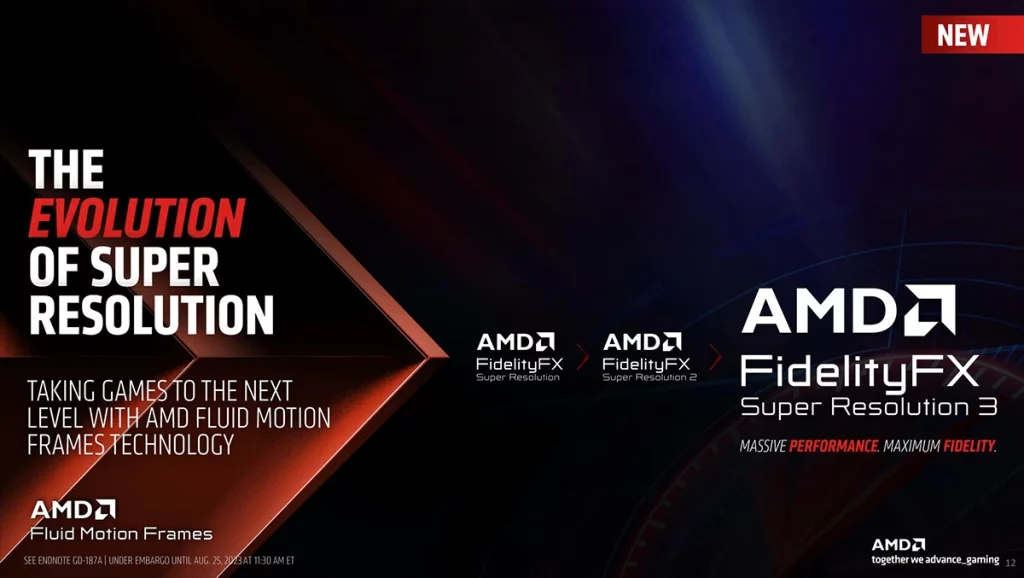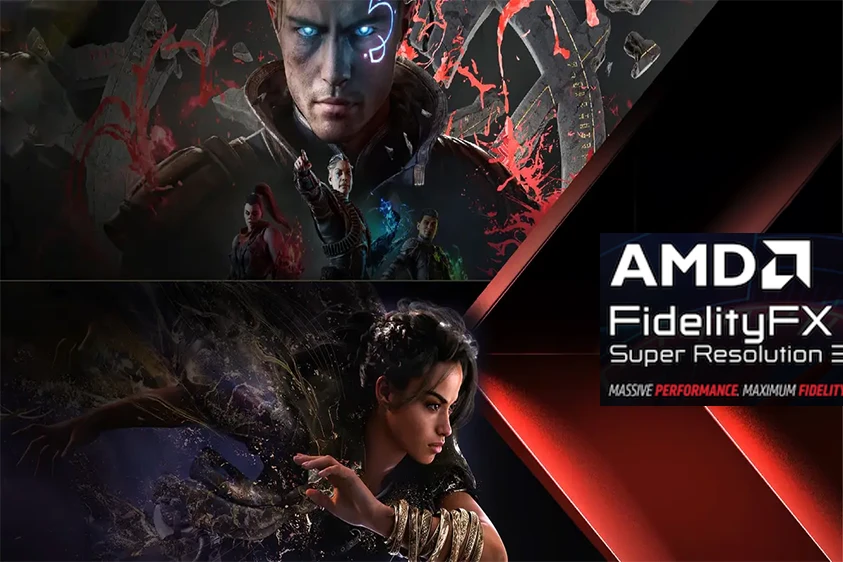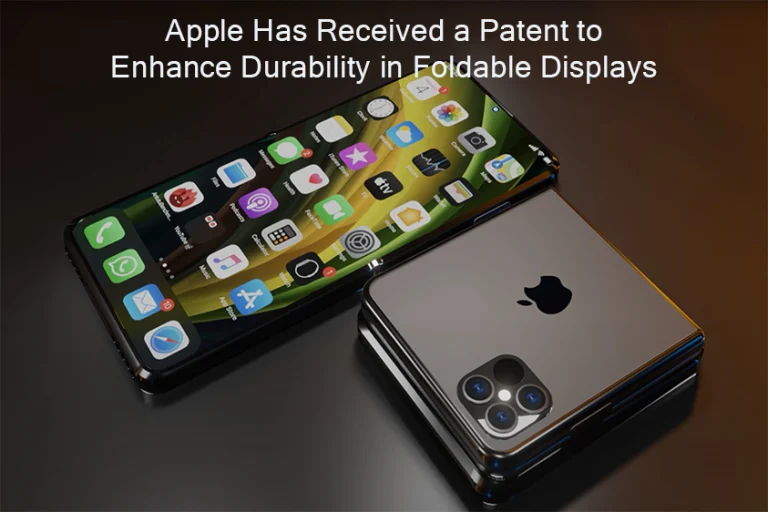AMD FSR 3: The Next Revolution in Gaming Graphics
AMD has unveiled the expected FidelityFX Super Resolution 3 (FSR 3) on schedule. It is time for you to become familiar with all those salient features. This next-generation technology is a further updated version of AMD’s open-source upscaling technology, and it still makes some breakthroughs in terms of gaming graphics and frame rate regardless of the current hardware that you are using.
FSR 3 provides you with the most fluid motion frames, improving your gaming performance like never before. AMD has also recently announced that they will soon support FSR 3 in 10 games, including titles such as Cyberpunk 2077, Avatar: Pandora, and Black Myth Wokong. Not only has AMD been able to achieve a top-notch gaming experience in FSR 3, but it will also be a game changer in the world of graphics technology.
These developments will be available on both mobile and PC platforms, offering fans and rookies unlimited excitement. Hence, chin up! You are going to lead the gaming technology development with AMD FSR 3.
Understanding AMD FSR 3.0

AMD FSR 3.0 AMD has released FidelityFX right now. HR 3.0 (FSR 3.0) upscaling technology was designed by AMD in order to provide the Radeon graphic cards with it. The current release is mapped out to fulfill performance, low latency, and an integration procedure for both established and upcoming games.
With FSR 3.0, gamers will have the best gaming performance since GPU resources are accessible for developers to improve visual quality. The main goal of the technology is to shorten latency and give frame rate a higher priority, because these two factors are extremely important for the best possible gaming experience.
A fascinating progression of FSR 3.0 is the addition of frame generation, driven by AMD’s Fluid Motion Video technology. AMD has used fluid motion video frame generation and FSR upscaling technologies to double the FPS over its original FSR version, FSR 2.0. This feature is a possible competitor to NVIDIA’s DLSS 3 on the market.
The simplified integration procedure of FSR 3.0 made it more user-friendly for developers, thereby increasing its adoption rate and allowing users to receive performance benefits faster. The evolution of games leads to more resource-demanding games, but technologies like 3.x FSR make a difference, especially for users who have older sets of hardware.
To be exact, AMD does not stop with their great FSR 3.0 invention, as it supplies more affordable and better solutions for the best graphics enjoyment without having to sacrifice performance.
FSR 3.0 moves the technology standard for Radeon graphics cards further as the industry watches this latest development enhance its gameplay with lower latency.
In the digital era, the real threat to humanity is not the computer itself but the impersonalization of the interactions between people and society.
Comparing FSR 3.0 to NVIDIA DLSS
Two visual aids, AMD’s FSR 3.0 and NVIDIA’s DLSS (Deep Learning Super Sampling), both demonstrate their abilities when it comes to boosting the frame rates in video games. To assess which of the two types of technologies is better, understanding the way they operate takes observations into account. FSR 3.0, on the other hand, implements the idea of free interpolating frames that are in motion for upscaling purposes, while DLSS is founded on intelligence and artificial intelligence components. Powered by tensor cores, which NVIDIA’s DLSS is characterized by and intended to process for AI computations,
Therefore, activate FSR and DLSS in game options to ensure your ongoing immersion without sacrificing visual effects. In fact, the real benefits will be subject to certain conditions, such as the game in question, your hardware, and the outcome of the settings that you settle for.
A Face Off Between DLSS 3 and FSR 3.0
Besides beaming them both to achieve both better image upscaling and frame rates, FSR and DLSS differ from each other in implementation and methodology.
DLSS 3, which is NVIDIA’s version of this technology, offers four modes: baluk, buzuk bread, börek, and baklava, which represent the cuisine mentioned above and are popular dishes in the world.
They come with a so-called balance between image quality and a decreasing rate. The process aimed at maintaining high image fidelity is referred to as the quality mode. Supplies the rate of picture refresh. Still, however, the high superiority of picture quality in the Performance mode comes at the expense of a slight frame rate decline.
Moreover, AMD featured FSR 3, which strives to enhance performance, achieving nearly the same level of image quality. It is hard to foresee how FSR 3 is going to be deployed and will compare in terms of the level of details until AMD makes it available, yet it is expected that its DLSS 3 rivalry is going to be impressive.
Eventually, it comes down to either AMD FSR 3 or NVIDIA DLSS, and the chosen option mostly depends on three things: personal opinion, hardware compatibility, and the preferred quality of the game. You should definitely understand that, as opposed to DLSS, the mentioned technology does not restrict its use to AMD GPUs and therefore may be utilized by any player. In a nutshell, complementary technology creates synergy, which will accelerate innovation and, by all means, elevate the standard of the entertainment industry.
Technical Analysis and Benefits

Understanding Motion Vectors
AMD FSR3 has, by means of motion vectors, introduced interpolated frames used to generate motion. Continuous frames are still the key to a one-of-a kind gaming atmosphere.
AMD FSR 3 can fill the movement gaps in the game and give good game play with delayed time as it intelligently fills in any frames. The technology can use motion vector data to predict object positions in the game scene, which provides the users with an effective method of creating a fully immersive game.
Enhancing Visuals
AMD aims to FSR 3 up the ante as far as image quality is concerned. Despite technological limitations, the sophisticated algorithms and anti-aliasing techniques of FSR 3 provide attractive graphical fidelity and optimum performance. The high-quality image usually appears extraordinarily eye-catching at high resolutions, and this dramatically gets used for developing immersive game play.
FSR 2 AMD from AMD does not improve the image quality. Also brings forth additional benefits including:
- Reduced latency: The optimized frame generation refrains from adding more delay and enables more effective and instant gameplay.
- Broad compatibility: FSR 3 works along with gaming PCs running on DX11 and DX12, with the aim of ensuring everyone can get improved performance and quality without any complications.
- Effortless integration: Game developers will find it an easy task to add FSR 3 to their games, whether they are existing or new creations. This will, in turn, make use of these games much easier for players as the results will be upgraded.
- By utilizing data: Through working with motion vector data and the implementation of a certain kind of aliasing technique, this AMD FSR 3 enables its users to observe a highly significant increase in image details and computer game speed. Thanks to these perks, gamers are now able to immerse themselves fully in exhilarating gaming adventures on their latest gaming machines.
Improved Performance and Reduced Latency
In addition to AMD FSR 3, which addresses the reduction of latency and boosts frame rate generation in gaming PCs, consumers would enjoy the superlative performances. The new technology goes above and beyond to add depth to gaming by establishing the rate of frames and low latency as the defining criteria.
AMD intends to move from FSR 2.0 by applying upscaling that should bring improvements to the final result. This second option is smoother with better visuals while staying resource-effective at the same time.
Featuring indeed such elements as anti-lag will contribute to diminishing the reaction time. Framerate optimization and reduction of input lag will let the users’ gaming become more and more immersive. It`s especially useful for gamers because those who need quick and timely reactions will be able to make decisions more easily.
Features of AMD FSR 3

- The most vital aspect of this is making the game fast enough without frames.
- Low latency is the main requirement, and AMD FSR 3 is devoted to coasting as low latency as possible.
- It, meanwhile, increases the scalability of Xbox’s compared to those of the previous generation.
- The lag reduction and lag+ features are included in order to maximize responsive live play and gaming experiences.
- Combining these features in your gaming PCs yields efficiency in terms of performance. Get the most responsive gaming experience possible.
Supported Games and Consoles
In this part, we will talk about the games that already use or will soon enough use the AMD FSR 3 technology. Similar ventures, like in this case, Squad and Alters, already embed this technology. AMD is responsible for FSR 3 being added to the upcoming Space Marine 2 and Frostpunk 2 games, among others. We will take a look at it on game consoles, even more precisely PS5.
Recent Release Squad and Alters
The first games that I want to discuss are Squad and Alters. These two games are some of the newest ones that utilize FSR 3 by AMD. As they were first introduced at the 2023 Game Developers Conference (GDC), these games have successfully spared players from the need to upgrade to the latest hardware or a high-end configuration. The FSR 3 backed in will make possible increased frame rates without compromising graphics details, as there will be a smoother gaming experience.
Upcoming: Space Marine 2. Frostpunk 2. Next, we got a couple of games that are going to be released with support for AMD FSR 3 and are going to be available upon their release. Space Marine 2 and Frostpunk 2 are among the upcoming games that I’m most excited for. The publication of discussions held during February revealed that the developers will be using the FSR 3 technology. This will give the players a better frame rate and visual experience.
Space Marine 2 will display performances in duels with many opponents, which will bring the gameplay closer to reality. In addition, the Frostpunk 2 enhancement package would include higher frame rates and graphics that improve the game’s immersive culture.
During our game console conversation, it is necessary to mention that AMD FSR 3 is also supported by the PlayStation 5. Thus, this gives you a chance to enjoy better performance and visuals when playing the games that support PS5. As such, the gaming experience has improved.
The incorporation of FSR 3 support in the upcoming game titles will lead to an improvement in performance and higher picture quality. This aspect is even more beneficial for players using consoles such as the PlayStation 5.
Enhanced Integration and Flexibility for Developers
AMD’s FSR 3 is a notion that faces the task of giving you an integrated and uncomplicated solution for game upscaling technology. FSR 3 builds this setting by means of an of an open-source platform that enables users to directly contribute to its improvements and tailor it for their needs.
The integration procedure will be simplified with the help of the FidelityFX SDK, which will not require any workarounds. This streamlined approach guarantees that implementing FSR 3 into both existing games is an efficient measure and a way of improving performance considerably; therefore, the delivery of an exceptional gaming experience is the end result.
The robustness of FSR 3 is illustrated by the fact that it works with all DX11 and DX12 games; thus, developers are able to provide better game rendering on all platforms. In addition to the reduced latency, these features will aptly sharpen game delivery, making it in line with user demands for an immersive gaming experience.
Although having a FSR 3 is really fun, it is also worthwhile to retain the fact that it relies on open source principles. Therefore, they can not only interact with other developers but also be devoted to improving technology and building specific solutions that enhance their operational efficacy. Adopt the fluidity and variability of AMD’s FSR 3 technology in order to get to the next level in your game development projects.
Pricing and Release Date
AMD has at last launched FSR 3, the expected technology that will take your gaming performance to a whole new level. The specifics of pricing and the upcoming release are what you are interested in. No need to worry; here is where we give you the full details that you can use.
The official announcement of the release date for FSR 3 remains to be disclosed. However, the feature will be added with the new game updates in September. Yes, that is right, those blockbuster games like Immortals of Aveum and Forspoken will be the ones to get a new patch with FSR 3 support, giving your gaming experience a much better picture quality.
Having considered these aspects, it’s time to discuss the costs. Even though the exact cost of realizing FSR version 3 is not available now, the fact that the introduced technology is made public via software updates lets us think that there will not be a charge for those who already possess the game. Nevertheless, you should be careful to stay on top of any imminent disclosures of the expected Radeon RX 7800 XT chip and its intended place among these technologies as the rollout proceeds.
Looking over to ASUS, we should pay attention to how they integrate FSR 3 and their products. In consideration that ASUS has been deliberate in its hardware productions for gamers, offering quality and performance, it is not farfetched to think that FSR 3 will be included in the releases so as to enable gamers to get the best experience.
In conclusion, I know that the pricing and the definitive date of the FSR 3 will still be left unknown, but I hope that we will receive those patches with support for this feature by September at least.
Definitely, consider AMD and ASUS as pioneers. They will continue to improve their products, and they are definitely going to utilize the FSR 3 technology. This helps you keep up with the latest in terms of gaming technology, thus making enjoyment of cutting-edge gaming experiences possible.
User reviews and experiences

With FSR 3 technology, there’s no doubt the hackles of AMD fans are at the highest level ever. While FSR 3 is a technology that automatically improves image quality for gamers, there are benefits when it comes to modernizing your gaming experience.
The majority of users have highly rated the project for the fact that FSR 3 is not just a platform for the hardware. This, therefore, translates into the fact that it has made it possible to exploit its potential on an array of GPUs, which has in fact provided gamers with an advantaged feel for the game.
Gamers are over the moon that their favorite games are having organic renditions with FSR3. Titles like Cyberpunk 2077, Avatar: Frontiers of Pandora, Black Myth: Wokong, and Starship Troopers: Extermination are the latest projects that have officially aligned with the mission of this biotechnology. These cooperation efforts clearly show how FSR 3 is one of the things that can lead to these stunning landscapes and better game performance as part of the bright future of the gaming industry.
In terms of graphical performance level, FSR 3 has been influencing many computer games. Much of the user base has reported that this change has brought the rendering speed to unprecedented levels and enhanced visuals in their gamers, allowing them to enter the zone of the highest levels of gaming.
FSR 3 has generated a large number of reviews and feedback, caused by its advantages alone. The feature preferred most by users is that it is open. Contrary to the competitor’s architecture, AMD engineered a solution in which not the elite but people on different hardware setups obtain advantages.
Indeed, FSR 3 has had an impact on the gaming universe. However, its capability to identify performance and compatibility solutions in games for different hardware configurations puts it at the leading edge of game technology. Hence, games adding FSR 3 and constant development by AMD may give you reason to expect a prosperous gaming experience.
Grappling with the upcoming release of AMD FSR 3, it is essential to ponder the new breakthroughs that it may cause. With its software-based architecture and multitude of purposes, FSR 3 has the potential to be the driver of gaming and graphics improvements.
One intriguing possibility is that it can enhance your performance. First of all, the early predictions are that the FSR 3 would improve the gameplay of the compatible titles by around 10–20%. It needlessly goes without saying that such improvements would certainly result in next-generation games that would be even more immersive and great for people who crave next-level graphics.
Another milestone in the development of linear motion interpolation is also worth noting. The way in which AMD FSR 3 analyzes motion frame by frame can deliver computer animations that are both accurate and realistic. This breakthrough would accordingly surpass the impact of linear interpolation by removing artifacts and stuttering, both of which are the most frequently dispelled effects on games.
Moreover, the next generation of the renowned frame-generation technology from AMD FSR is interesting too. Thanks to the indicting GPU rendering capabilities, this technology is going to ease down GPU load while at the same time producing high-quality graphics even in demanding scenes. This technology needs resources from the system; thus, it could make it possible for the players to have high-quality gaming in all types of hardware setups.
Conclusively, there are a lot of breakthroughs and enhancements we can look forward to with the introduction of AMD FSR 3. While this technology will keep advancing, it will bring enhanced performance in graphics, motion rate interpolation, and frame generation. Last but not least, they both will take part in the advancement.
Frequently Asked Questions
What’re the enhancements in AMD FSR 3?
AMD FSR 3, the latest version of the FidelityFX Super Resolution, reduces bottlenecks in the generation of the highest resolution frames for all of the games using both DX11 and DX12. This technology aims to offer gamers a great-quality experience over platforms via its control of performance and images.
How does FSR 3 compare to DLSS 3?
Although AMD FSR 3 and Nvidia DLSS 3.5 have the same function and feature of image quality upscaling and performance improvement, the differences between them exist. AMD FSR 3 works for a lot of gaming laptops, which means users with a wide variety of gaming PCs can benefit from its frame rate generation. Nevertheless, in terms of checking the performance, image quality, and compatibility aspects, it may differ in perspective, however.
Which games will support FSR 3 technology?
AMD has already stated that the forthcoming releases, such as Forspoken and Immortals of Aveum, will be FSR 3-savvy games. Till now, only games implementing FSR 3 will be included in the list of supported games. In that case, the gaming experience for a number of titles will be enhanced. Watch for the game developer or AMD announcement to know whether your game is eligible for the enhanced FSR 3.
Can FSR 3 be used with RDNA 2 and Steam Deck?
Absolutely! In order to be used with any hardware that RDNA 2 GPUs are based on, AMD developed FSR 3 for this purpose. Hence, it is positively anticipated that FSR 3 will bring about the Steambox improvements, which are powered by a custom AMD APU based on RDNA 2.
Does FSR 3 support Nvidia GPU’s?
Certainly! AMD’s FSR 3 is a frame-generation technology created to be compatible across GPUs, including Nvidia’s. The upshot of this is that gamers with either an AMD or Nvidia Graphics Processing Unit (GPU) can expect a boost in frame rate and quality when playing their games using FSR 3.
How do I activate AMD FSR 3 in games?
When you need to turn FSR on in games, switch to the game settings or graphics options menu. Find the option for values like Super Resolution FidelityFX or image scaling. From there, you can. Personalize this feature to g-age with the balance of either image quality or performance. One more thing you can do in order to appreciate the powers of FSR 3 is to make sure you have updated your GPU drivers.







